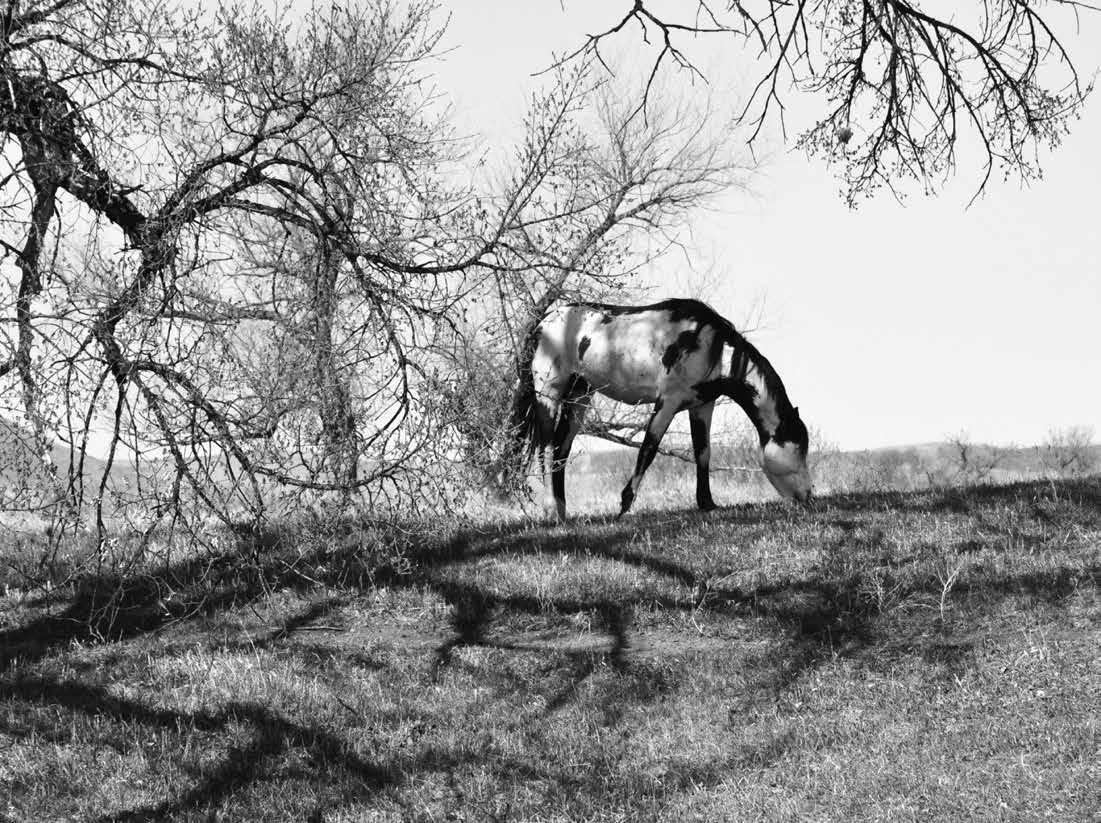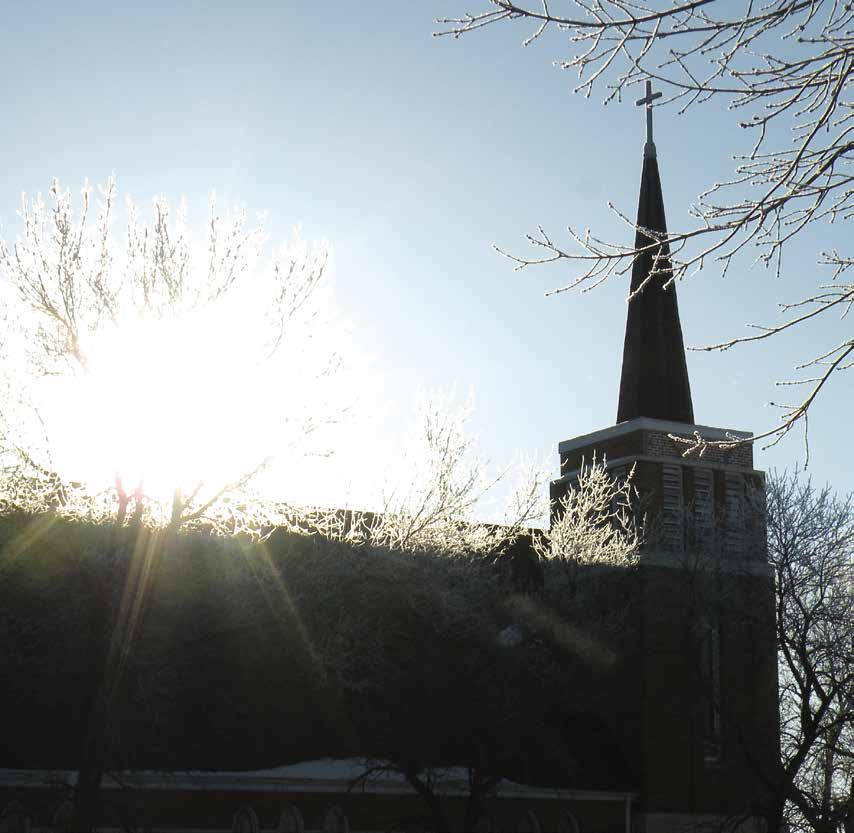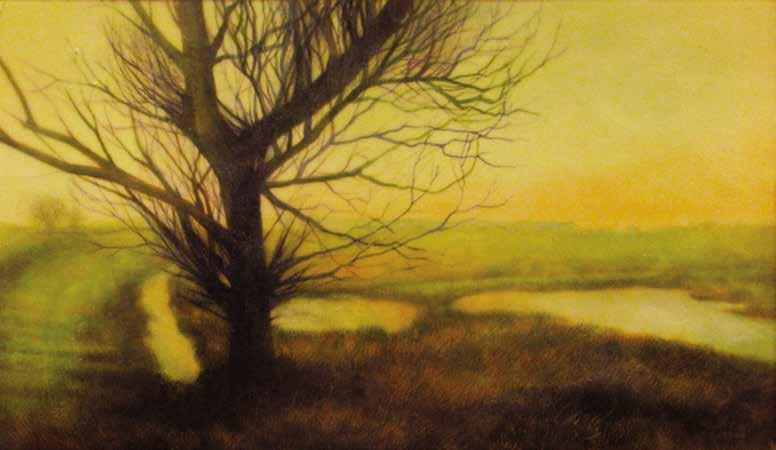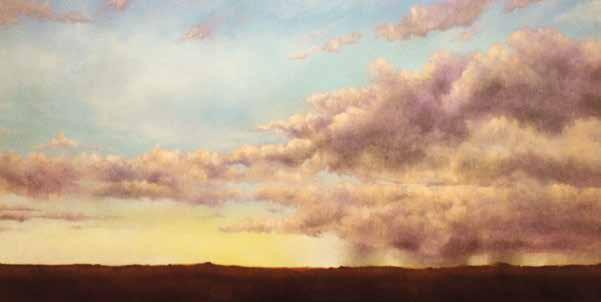
10 minute read
Writing the Prairie: Can You Really Do That Here?
David Boggs, Sunset Over Marshlands II. Oil on canvas, 24” x 48”
By Taylor Brorby
Advertisement
For the past several years I have been practicing sentences. Yes, practicing; that’s what writers do. Writers often go back in their memories to mine from experiences that help shape their perceptions of the present and the future. In my recent mining, I have been thinking about writing and North Dakota.
North Dakota’s landscape is wide and expansive; it is not too hard to imagine that, in some particular—or maybe peculiar—way, it contains the entirety of creation. The Red River Valley reminds me of what the earth might have looked like after the great flood Noah experienced; the badlands hold not only the mystique of the American West, but also dinosaurs; the Missouri River has a rich history of buffalo, bear, indigenous culture, along with the Corps of Discovery; Lake Metigoshe, with its meandering lakefront, allows the mind to contemplate the beauty of birchbark trees in autumn. North Dakota has such wonderful names for its geography, like the Turtle Mountains, Bullion Butte, and the Petrified Forest. There is room for a story to let loose in many of the human-made features as well: the village of Fort Ransom, the Peacock Alley Bar in Bismarck, and the Whirl-A-Whip ice cream machine in Stanley are all uniquely North Dakotan.
In the words of the seventeenth-century writer and angler, Izaak Walton, the writer must study to be quiet. He (and I use this gender pronoun only because I am a male writer) must quiet his mind in order to listen to his imagination. Annie Dillard, in her 1989 essay, “Write Till You Drop,” gave this sound advice about writers: “She is careful of what she reads, for that is what she will write. She is careful of what she learns, because that is what she will know.”
So what have many North Dakota writers learned and come to know? To succeed in being a writer they must leave. Louis L’Amour settled in Los Angeles; Rich Karlgaard lives in the San Francisco Bay area; Maxwell Anderson lived in Palo Alto before retiring to the East Coast; Eric Sevareid died in Washington, D.C.; James M. McPherson lives in Princeton, New Jersey; Chuck Klosterman, who writes a weekly ethics column for the New York Times, lives in New York City. Louise Erdrich, winner of this year’s National Book Award, and her sister, Heid Erdrich, both live in Minneapolis. Those who are young and are ambitious to write learn early to get out.
But there must be something else. After all, two famous North Dakota writers (who are not read in North Dakota schools) have resided in the state. Kristjan Niels Julius, the famous Icelander who moved to Thingvalla Township near Mountain and is buried there; and Larry Woiwode, recipient of numerous awards and accolades, who has been the state’s poet laureate since 1995, lives a few miles from Mott, although he too left his birthplace for several decades while he honed his craft.
Could the literature about North Dakota be the reason so many writers leave or never come to live in North Dakota? Maybe, but I think not. Yes, Debra Marquart’s well-written memoir The Horizontal World: Growing Up Wild in the Middle of Nowhere paints North Dakota as a place where, as soon as you can drive, you should get the hell out; and Ole Rolvaag’s Giants in the Earth does not necessarily paint a lovely scene about life on the prairie.
In contrast to these two books there are so many moving—and exciting—books that come out of this wind-blown, prairie landscape: Chuck Klosterman’s Fargo Rock City (which is actually about growing up in Wyndmere) helps to define what heavy metal meant for a generation; Kathleen Norris’s Dakota: A Spiritual Geography examine’s the religious life lead on the prairie and what the Benedictine tradition inspires her to contemplate; Eric Sevareid’s incredible memoir, Canoeing with the Cree, documents the difficulties in paddling from Minneapolis to the Hudson Bay, with much of the journey taking place along the Red River. If that isn’t enough, almost the entirety of Louise Erdrich’s moving and complex body of work is set in imaginary (and some actual) places in North Dakota. There is much written about the Peace Garden State.
I am not convinced, though, that all is at peace with the thought of having writers in North Dakota. Writers are dissenters and dissidents; that is, they probe and poke, examine and question, beleaguer and assault received wisdom, values, and assumptions. Writers help hold mirrors to our flaws and foibles. This does not sit well with those of us who have insecurities.
And a place’s oddities do not warrant defensiveness. I think it is odd that where I live (in Minnesota), we have a Spam history museum, and that the town of Aitkin has a fish house parade, and that Luverne has the Tiny Church, which seats four people. Those things are odd, aren’t they? But in Minnesota I am able to write about them, point out how odd they, in fact, are, and I am—usually—able to get people to agree and laugh with me about these funny things.
North Dakota has some oddities, too, like the collection of roadside art from the Enchanted Highway to a series of huge animal statues: Salem Sue, the Holstein cow in New Salem; the world’s largest buffalo is in Jamestown; Turtle Lake’s Rusty the Turtle, and Steele’s Sandy, the world’s largest sandhill crane. The state offers an unlimited array of potentially humorous subjects for writing.
But writing is not always humorous, and that is part of my worry about living and writing in North Dakota. Good writing—writing that can be funny, deep, complex, and insightful—should be unsettling. And writers are also unsettling. It is true that it is often hard to see the work that a writer is doing, much of it happens in solitude or in his head. And in a harsh landscape that prides itself on hard labor, this might be viewed as suspicious. Writers are forced by nature and the constrictions of their vocation to read, to think deeply, and to practice sentences. This is hard work. Try it. Yes, bringing in the fall beet harvest is difficult, and so is raising cattle, and so is working in the Bakken oil fields. But writing a well-turned sentence can also be laborious.
In his insightful essay, “On Apprenticeship,” Bill Roorbach recounts an experience that is familiar to most writers:
-
"At a Christmas gathering back home in the flatlands of Connecticut I got stuck at a house party talking to a real estate lady and her banker husband. Nice folks. She had read my book, a memoir called Summers with Juliet, which chronicles eight summers spent traveling with my now wife, the painter Juliet Karelsen. He had not read the book, even grinned and admitted he hadn’t actually read a whole book since college. Maybe not even in college, ha ha.
And she said, “We could have written that book.”
“Yes!” he cried, “All the adventures we’ve had!”
“And the long courtship, too,” she said.
I liked her. Who wouldn’t? Lovely, intelligent, active, charming, successful.
He said, “Always wanted to take off a month and write the darn thing!” He really said this. A pleasant banker who hadn’t read a book maybe ever.
“This is before we settled down,” she said.
“Rent a little cabin, write the darn thing,” he said, dreamily. Some of his rough edges, most of the possibility of personality, had been rubbed off by banking, but not all. There was enough of a man left there to take him seriously.
I smiled, said nothing. I’m not entirely churlish sometimes and I know people say dumb things sometimes. I do have a sense of humor. And I have had such conversations before . . .
A doctor at a conference in Montana (and a doctor at Stonecoast and a doctor at Steamboat Springs and a doctor at every conference I’ve ever braved teaching—doctors are famous offenders) strode up to me during cocktails and announced that—now that she was established as a surgeon (in fact, perhaps a little bored with it by now, the glamour having worn off)—yes, now that she had control of her time, she was going to take six months off and write her story. Mine had inspired her, she said.
I said I was pleased to be her inspiration. I wished her luck. Then there was a pause. The rattling of ice cubes. I knew how smart it would be to keep silent, but I gulped my drink and said, “You know, you’ve inspired me! I’m going to take six months off and become a surgeon like you, since I admire you, and since neurology seems most up my alley—after all, I work with my brain practically every day! Yes! That’s it! Now that I’m an established writer, I think I’ll just take six months off and heal a few brain wounds.”
-
I share this story because I think it gets at something in the North Dakota mentality. Those of us who have had the benefit of growing up in a state known for its safety, wide-open landscapes, and friendly residents, also wrestle with its consistency. Good, hard, manual labor has been here from the state’s incorporation into the Union. Those of us who have done well both in and outside of the state have succeeded due to the principles and education we received in North Dakota. The state has the ability to create one of the most incredible creative writing programs in the country due to its excess funds from the Bakken oil boom. Why not? Places just as rural, such as Iowa and Montana, have the good benefit of two of the most highly esteemed writing programs in the country. And what about writing colonies and writers’ retreats? Jentel Artist Residency Program is housed twenty miles outside of Sheridan, Wyoming, and just eleven miles to the east UCross holds its own residency. Minnesota has numerous opportunities for writers, including the Lanesboro artist residency, the Anderson Center in Red Wing, and The Loft Literary Center, one of the nation’s leading literary arts centers.
North Dakota has no such opportunities.
Consistency is one North Dakota value: the harvest can always be counted on occurring; children roll back into their school schedules come August; Bismarck, Fargo, and Grand Forks might get a new restaurant that is the talk of the town for the next few months. But, as Ralph Waldo Emerson pointed out, “With consistency a great soul has simply nothing to do.” However, I’m still not convinced there is nothing to do in North Dakota. Maybe it is how we have come to view the state with the well-worn idea that the cold weather keeps the riffraff out. I say let the riffraff in, embrace it, and welcome it with open arms. After all, artists can be an interesting species of riffraff.
One thing North Dakota can pride itself on is its ability to inspire stories. Before visiting our home on Lake Sakakawea, my college friends had never seen fields of sunflowers before. They scrunched their faces against the windows just to be closer to those amazing yellow giants. The floods, the settlers, the dinosaurs, Ellendale’s opera house, and Casselton’s Can Pile all provide plenty of writing material and the foundation for a good story.
The writer-farmer William Kittredge helps us get at it in a different way: “We live in stories. What we are is stories. We do things because of what is called character, and our character is formed by the stories we learn to live in. Late in the night, we listen to our own breathing in the dark and rework our stories. We do it again the next morning, and all day long, before the looking glass of ourselves, reinventing reasons for our lives. Other than such storytelling, there is no reason to things.”
So what are the stories we are telling? Do they only include farming as a job or do they help us see how imaginative and creative farming is? Can we share stories that help others see how beautiful a sunset in the badlands might be? Did you ever hear the story about Aunt Lizzy and the time the boat motor gave out on Lake Sakakawea?
Here is my question for you: Are you putting pen to paper? Because, after all, writing is more than a hobby— like farming, it is a way of life. We need curious people to observe their surroundings, collect and share stories, and, at the start of the day, go into their writing room and sit with themselves and say, “God, it’s good to be a writer in North Dakota.”
A native of Center, North Dakota, Taylor Brorby is a writer and environmentalist based in Minneapolis, MN. Taylor has received grants and fellowships from Hamline University and St. Olaf College. His work has appeared on Minnesota Public Radio, in the journal Rock, Paper, Scissors, Augsburg Fortress Press, in newspapers, and The Huffington Post, where he writes on education.










